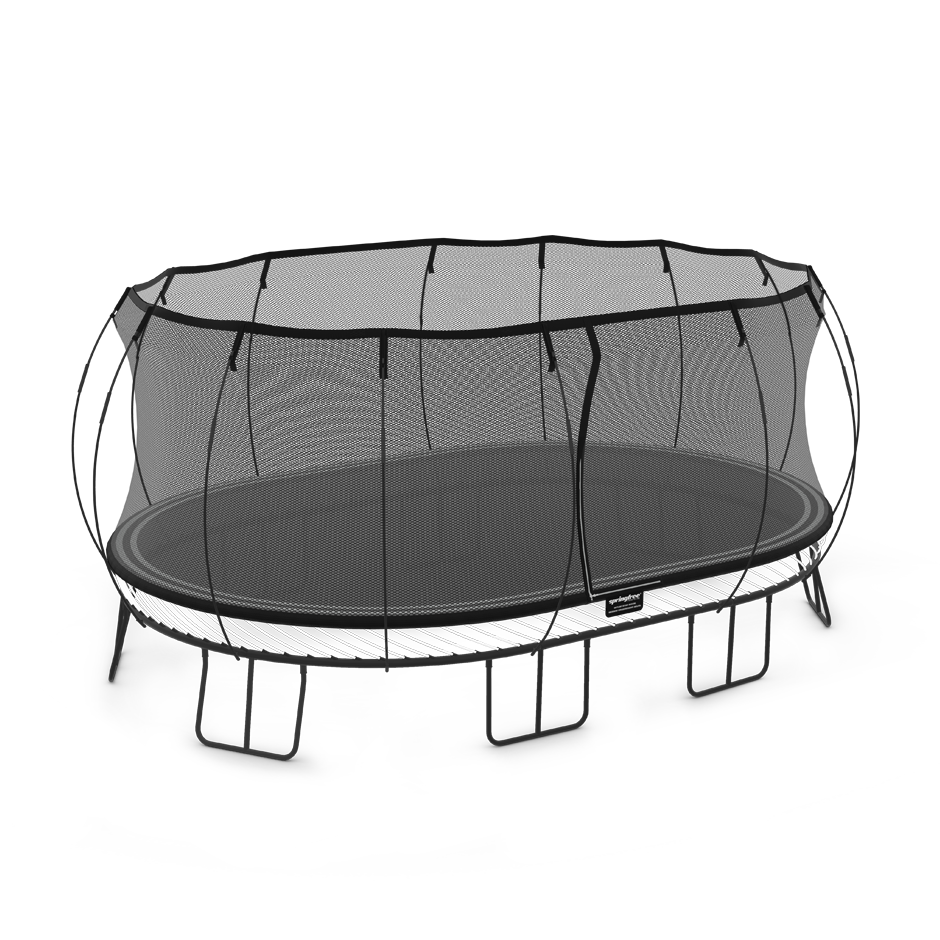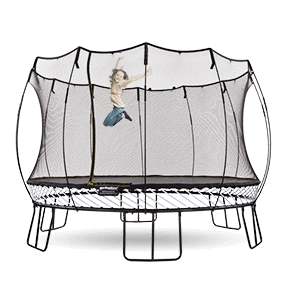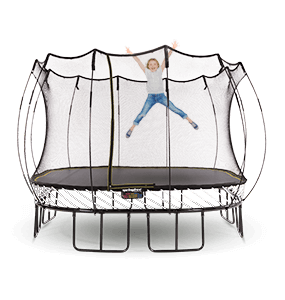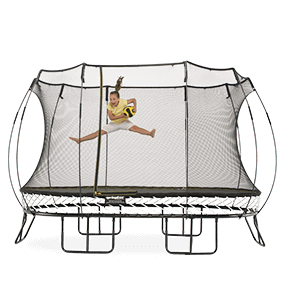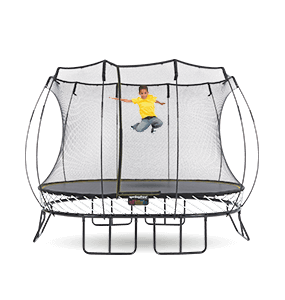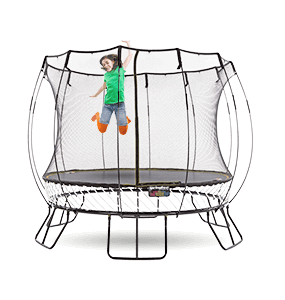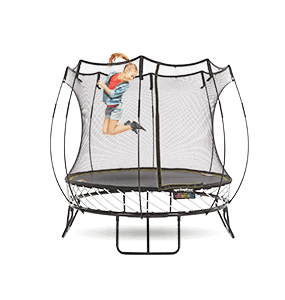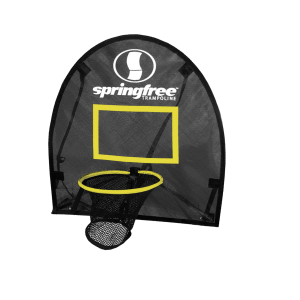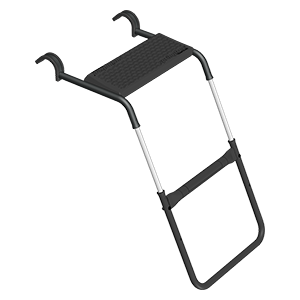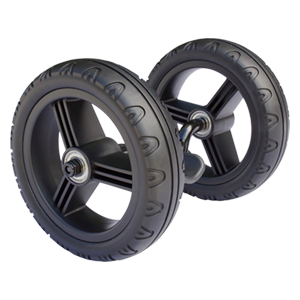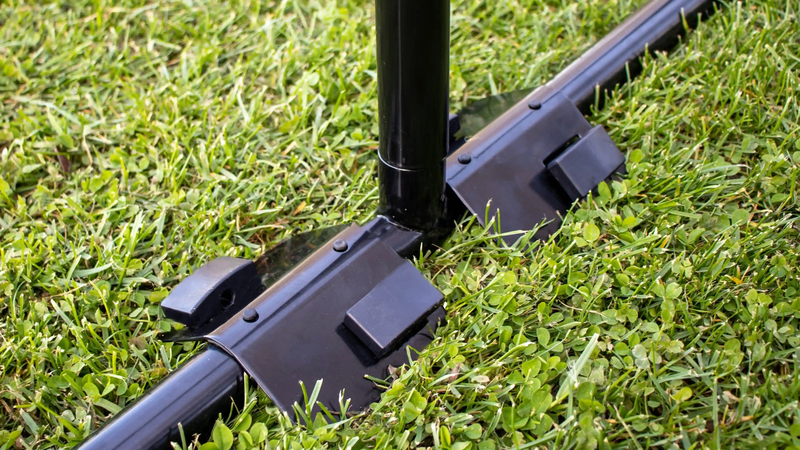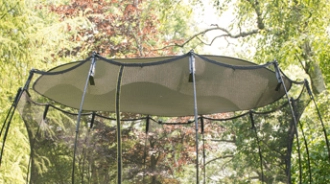Frequently Asked Questions
Have a question? Below are some of our frequently asked questions.
How does Springfree Trampoline work?
Springfree Trampoline is a rod based trampoline – using strong flexible fibre glass rods instead of springs. Imagine a circle of fishing rods standing upright with their handles stuck firmly in the ground. If you bent them all in towards the center and connected the tops of them with a tight material, you would basically have a workable trampoline. If you landed on the edge, you would spike yourself on the end of a rod - not a good thing. So instead of keeping the rods standing upright, we have angled them over. They have the ends bent towards the center, so they keep the mat tight. But if you land on the end of a leaned over rod, there is no hard impact, as the rod systems absorbs the force of the jump and is gently pushed down. This gives a soft and safe edge to the mat.
Is it as bouncy as a traditional trampoline?
The Springfree Trampoline offers a softer bounce smoother bounce, and doesn’t produce the jarring effect of traditional, spring based trampolines. The fibreglass rods deliver a performance superior to springs and one that is a lot gentler on knees and joints. Each of our models is designed for slightly different weights and usages. Our model selector should help select the trampoline that will provide the best rebound for your families average weights.
How soft is the edge?
The edge is not as soft as the center, but it has up to 350mm of give in it. Testing to USA ASTM standards shows the Springfree Trampoline edge is over 20 times softer than what is required by the Standard.
Is the SoftEdge bouncy?
The Springfree Trampoline SoftEdge is designed as a resilient surface that is safe to land on. It is not really designed as a bouncing surface. It is not as bouncy as the center, but it does have some bounce in it. We recommend that for best bouncing you should stay near the center of the mat, and consider the edge as a safety feature rather than a play area.
Can you get splinters in your hands from the fibreglass?
All the hi-tech fibreglass rods in the Springfree Trampoline are housed in a light plastic sheath. This not only protects you from skin irritation or splinters, but it also protects the plastic in the rods from UV deterioration.
Why doesn't it have safety pads around the edge?
The Springfree Trampoline does not have safety pads around the edge because it doesn't need them. The edge itself has much more give in it than normal safety pads. In fact, the Springfree Trampoline edge is nearly equivalent to the 70mm thick padding used at the ends of Olympic gymnastic trampolines. Conventional trampolines require safety pads to protect the jumper from falling on the steel frame, falling through between the springs or getting caught in the springs. However, testing shows that these pads do not absorb enough impact attenuation to protect jumpers from impact on the springs and frame. The Springfree Trampoline design has removed these elements completely, so there is nothing to pad over.
Other tramps have enclosures, what is different about the Springfree Trampoline enclosure?
While some other trampolines may also have enclosures they haven’t addressed the dangerous springs and steel frame at the jumping surface. Basic enclosures are also likely to just redirect wayward jumpers back onto the springs and frame. They also use steel rods to create the enclosure skeleton which introduces another impact risk. Springfree Trampoline is the only trampoline that addresses these impact zones, removing them completely from the trampoline design. By incorporating a safe FlexiNet that is fully deformable on all planes, jumpers are gently redirected back to the centre of the trampoline, without the introduction of rigid enclosure supports.
Is my spring-based trampoline really that dangerous?
Yes! Recent figures show nearly 100,000 US kids end up in hospital emergency departments after injury on traditional trampolines. Springfree Trampoline is the only trampoline that has removed the design elements responsible for 83% of this total number of hospital presentations.
Why do you recommend only one child JUMP on the trampoline at a time?
Springfree Trampoline has engineered out the product elements that traditionally cause trampoline injuries (springs, frame and rigid enclosure, or falls to the ground). Serious collisions can occur if more than one person jumps at a time. To ensure your family avoids injury, enforce the ‘one at a time rule’ when jumping on the Springfree Trampoline.
I have a small backyard, how much space do I need for the Springfree Trampoline?
The minimum space around each trampoline is 1 m in Australia, 1.5 m in North America and 2 m according to the European norms.
What is the weight recommendation on a Springfree Trampoline?
The Springfree Trampoline is incredibly strong, with our smaller model tested to take a static load of 600 kg and our larger models 700 kg. This means it can carry more than 700 kg placed on the centre of the mat without exceeding its design criteria. That's about the weight of an adult male polar bear. Recommending jumper weight is a more complex issue, as a suggested weight limit would need to combine the velocity of the jumper, weight of the jumper, and height of the jump off the mat. As we are focused on safety we recommend the following weights as a safe, conservative guidelines for each model:
- R54 – 80 kg (R54: According to the new EN standard, Springfree must print max. "50 kg" on the manuals of the R54. The trampoline is still advertised in all markets outside the EU for up to 80 kg and is clearly designed for this weight)
- R79 – 100 kg
- O77 – 100 kg
- O92 – 100 kg
- S113 – 100 kg
- R132 – 100 kg
- O200 – 100 kg
This doesn’t mean someone over these weights can break or tip the trampoline, it means they could run the risk of ‘bottoming out’ (a fancy word for hitting the ground) if they were to be jumping like the world’s next Olympic trampolinist! In this instance, we suggest increasing the clearance under the trampoline, by digging around 25 cm to provide extra clearance room at the bottom of the jump.
Can a jumper hit the ground even though there is a net?
Our enclosure is not designed to be a rigid resistant surface, rather a flexible cushion which catches wayward jumpers and guides them to safety - usually back to the centre of the mat. Rigid enclosures can cause injury upon impact, making the jumper absorb the impact. This is exactly what the Springfree Trampoline FlexiNet is designed to avoid. The FlexiNet is purposefully flexible in order to absorb the impact on behalf of the jumper, ensuring the jumper's safety even when they overbalance at the mat's edge. Even if the FlexiNet is misused by intentionally jumping into the top of enclosure at high speed then its key design characteristics will maintain jumper safety. It is designed to be flexible, fully deforming and, in the case of severe misuse, still allow the jumper's body weight to be absorbed and lowered to the ground, minimising the impact. For example, if a jumper is close to or in excess of 100 kg, running at a speed of 25 km per hour, and throws themselves directly into the FlexiNet at a height, there is a potential for a controlled ground impact. In this extreme situation the flexible net system is designed to lower the jumper to the ground slowly and safely. It is important to understand that any such ensuing ground impact is actually gentle because the net system absorbs the energy and slowly lowers the jumper. Any such impact is equivalent to a fall height of about 10 to 15 cm depending on the aggressiveness of the initial jump. Remember, Springfree Trampoline is designed its trampolines with maximum user safety in mind, and the FlexiNet is designed to cushion and catch a jumper so no or minimal impact is transferred to the jumper.
Do the Springfree Trampoline rods twist?
At first glance it looks as if the Springfree Trampoline rods would twist during a bounce. In fact the effect is undetectable in normal use. Springfree Trampoline's patented fibreglass rods are designed to work in unison, to bend inwards as a jumper bounces, with about 0.3 of a degree of twist. This equates to ~5 mm movement in a lateral direction, i.e. sideways/rotationally at the edge of the mat surface. All other movement is “axial”, or inwards, towards the center of the mat. Heavier jumpers (upwards of 100 kg) will generate more axial movement, but little to no more lateral/rotational movement at the mat edge. Lighter jumpers will generate less of both movement. This movement is not only undectable in use, but provides no affect to jumpers.
Is the Springfree Trampoline weather proof?
Yes! The Springfree Trampoline is designed to stand the test of time! All components are weatherproof and UV protected.
More Questions?
Please contact us directly info@springfree.de.


